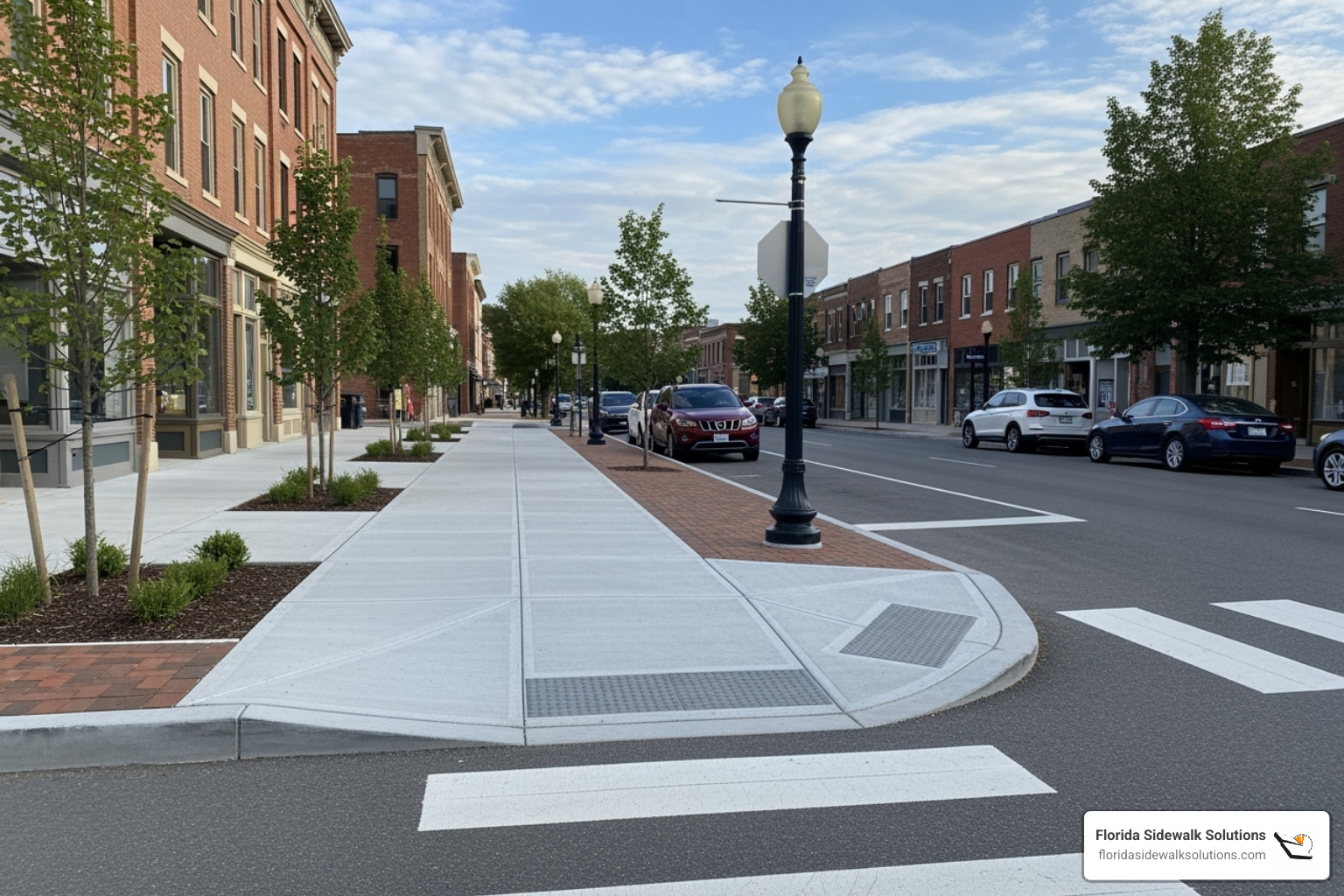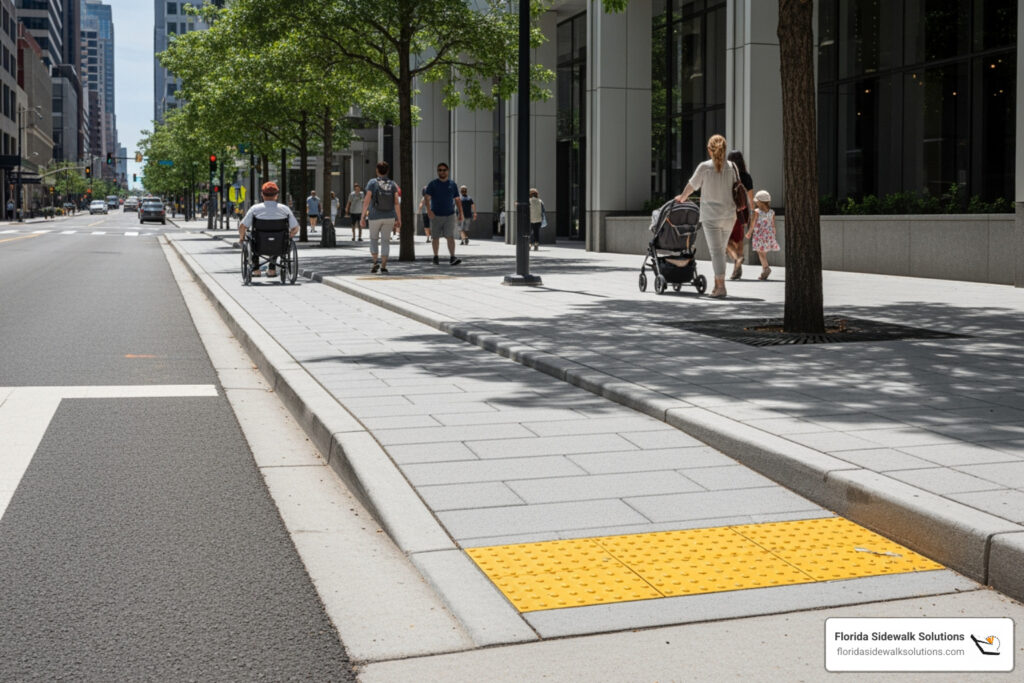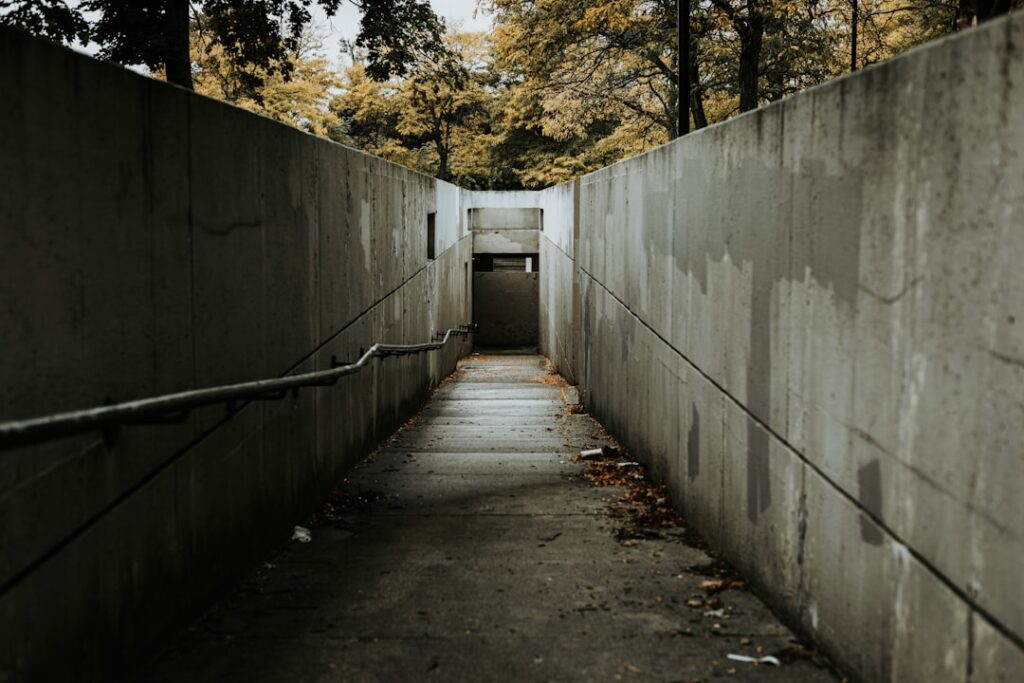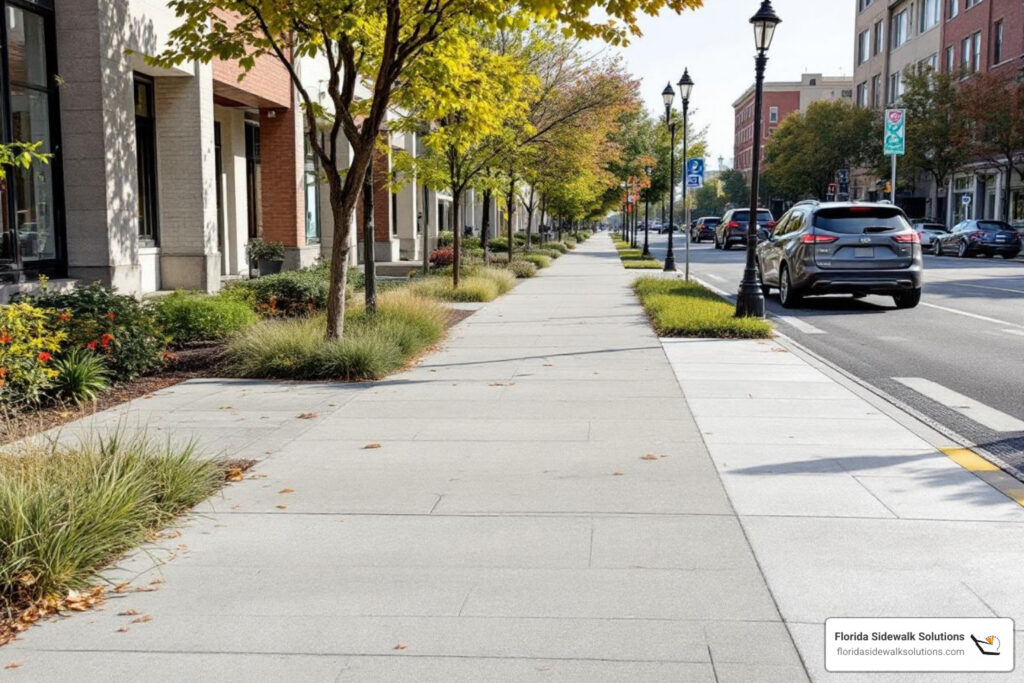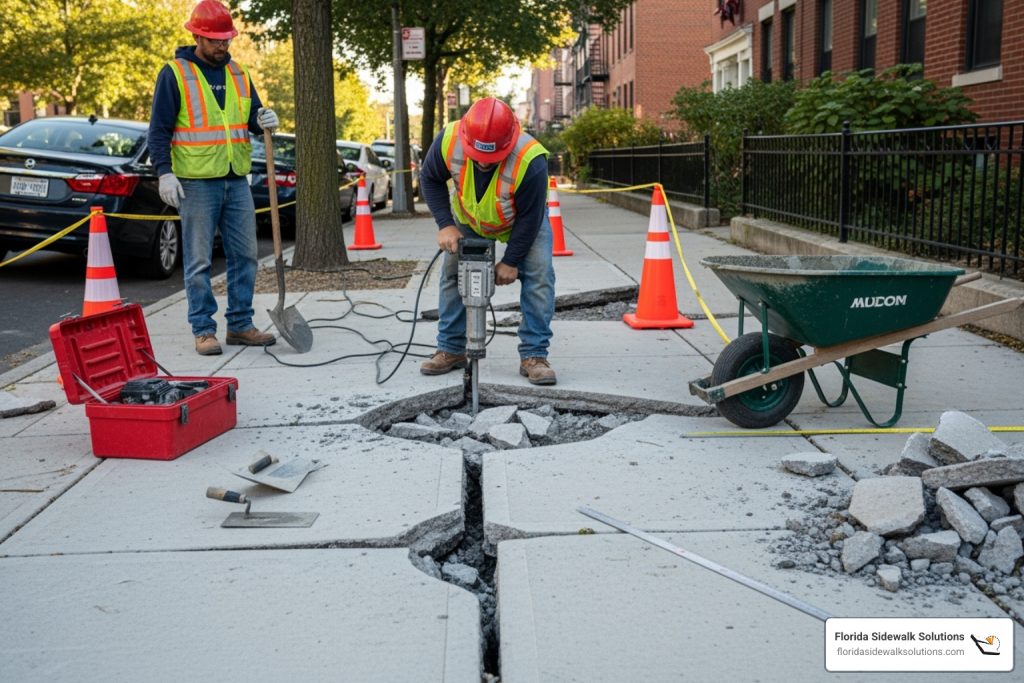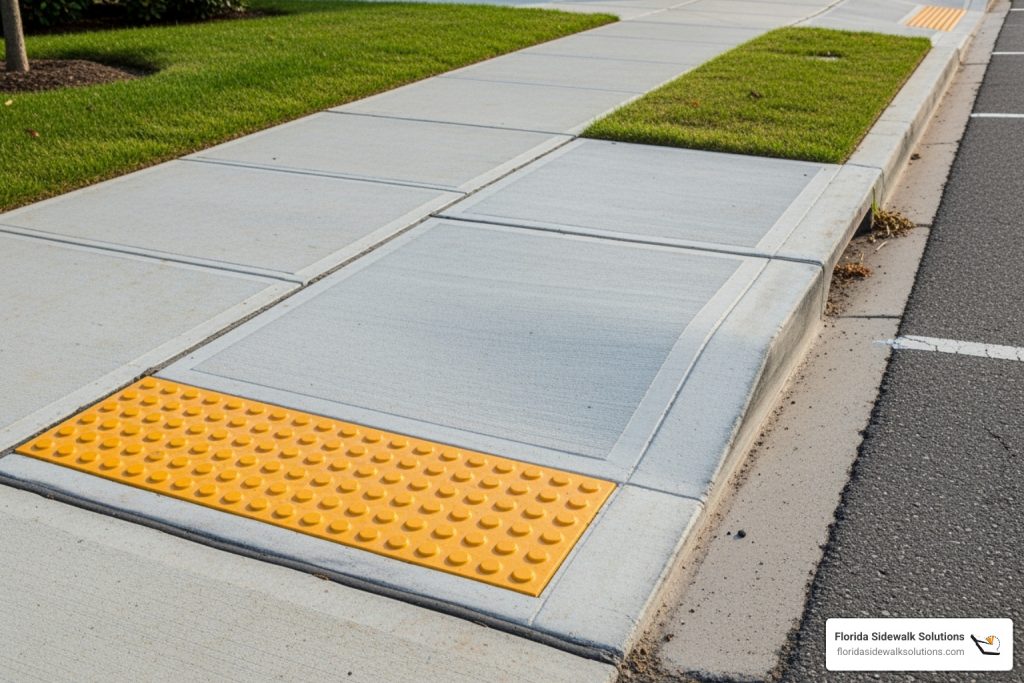Why ADA Compliance for Sidewalks Is Your Legal Responsibility
ADA compliance for sidewalks is a legal requirement that ensures public walkways are safe and accessible for people with disabilities. The Americans with Disabilities Act sets specific standards for sidewalk width, slope, surface quality, and trip hazard removal to protect pedestrians and reduce liability for property owners.
Quick ADA Compliance Requirements:
- Minimum width: 36 inches (3 feet)
- Maximum trip hazard: 1/4 inch vertical change
- Running slope: No steeper than 1:20 (5%)
- Cross slope: No steeper than 1:48 (2%)
- Passing spaces: 60×60 inches every 200 feet for narrow sidewalks
As a Municipal Maintenance Manager, you face the challenge of keeping public sidewalks safe while managing tight budgets. Non-compliant sidewalks create serious risks – both for pedestrians who might trip and fall, and for your municipality that could face fines up to $75,000 for first violations and $150,000 for repeat offenses.
The most common compliance issue? Trip hazards. Any vertical change over 1/4 inch at sidewalk joints or cracks violates ADA standards. These hazards often develop from tree roots, concrete settling, or normal wear and tear.
The good news is that achieving compliance doesn’t always require expensive full replacement. Modern concrete cutting methods can remove trip hazards precisely while preserving the existing sidewalk structure – saving both time and taxpayer money.

The ‘What’ and ‘Why’ of ADA Sidewalk Compliance
Think of ADA compliance for sidewalks as your community’s promise of safe, independent mobility for everyone. It’s not just about rules; it’s about creating spaces where a parent with a stroller, a wheelchair user, or a person with a visual impairment can steer with confidence.
The Americans with Disabilities Act became law in 1990, changing public spaces. This legislation made it clear: discrimination against people with disabilities is illegal, and sidewalks must work for everyone. What is the ADA? goes deeper into this landmark law.
Non-compliant sidewalks are accidents waiting to happen. A small crack or raised slab can cause a fall, especially for those with mobility or vision challenges. Prioritizing accessibility isn’t just a legal checkmark; it’s actively preventing injuries, reducing liability, and building community trust.
Every compliant sidewalk becomes part of the public right-of-way network that connects our neighborhoods, schools, businesses, and parks. It’s infrastructure that truly serves everyone.
Who is Required to Comply?
The ADA casts a wide net because accessibility is not optional when you serve the public. If people use your facilities, you likely need to meet ADA standards.
Public entities have the greatest responsibility under Title II of the ADA. State and local governments must ensure all their facilities, including every public sidewalk, meet accessibility standards. This applies to new construction and requires retrofitting existing facilities to meet current standards.
Commercial facilities and places of public accommodation fall under Title III. This covers a vast range of businesses that welcome the public, including retail stores, restaurants, hospitals, office buildings, and transportation facilities. Many organizations and businesses find they’re covered by these requirements.
The key date to remember is March 15, 2012. Any project that began on or after this date generally must follow the 2010 ADA Standards. But even older facilities aren’t off the hook – major renovations or alterations trigger compliance requirements for those updated areas.
Exemptions from ADA Guidelines
While the ADA is comprehensive, a few specific exemptions exist.
Religious organizations typically don’t have to follow ADA guidelines for their places of worship. Private clubs with bona fide membership restrictions also generally receive exemptions.
Private residences are an interesting case. A single-family home or private apartment isn’t typically covered by federal ADA guidelines. However, if its sidewalk connects to public walkways or serves as part of a public thoroughfare, different rules may apply.
Federal agencies must also provide accessibility, but they follow the Architectural Barriers Act of 1968, a different set of guidelines with the same goal.
State and local regulations can set higher standards than federal requirements. Always check with local authorities to understand what applies to your situation.
Core Technical Requirements for ADA Compliance for Sidewalks
For ADA compliance for sidewalks, specific measurements from the 2010 ADA Standards are crucial. These requirements are designed to ensure people using wheelchairs, walkers, and other mobility aids can steer sidewalks safely and independently.
This creates a seamless pedestrian access route—an unobstructed path connecting key destinations. These standards apply to new construction and alterations. When making significant changes to existing sidewalks, you must bring them up to current standards, making these requirements crucial for public walkway managers.

Width and Passing Spaces
Navigating a narrow hallway with a wheelchair is challenging, which is why the ADA sets clear width requirements for sidewalks.
Every compliant sidewalk needs a continuous clear width of at least 36 inches. This three feet of unobstructed space must be maintained along the entire route. There are a couple of exceptions to this rule: the width can narrow to 32 inches for a 24-inch stretch, but only if separated by wider sections that are 48 inches long and 36 inches wide.
If a sidewalk is narrower than 60 inches, you must include passing spaces. These are 60-by-60-inch areas spaced no more than 200 feet apart, allowing two people using mobility devices to pass or turn around.
Maneuvering at turns requires special attention. Walkway width requirements increase to 42 inches for smaller obstructions and 48 inches for larger ones.
Slope and Cross Slope
Slopes are a critical aspect of sidewalk accessibility. Getting the two types of slope correct is essential.
The running slope—the slope in the direction of travel—cannot exceed 1:20 or 5%. A steeper sidewalk is considered a ramp and must meet stricter requirements.
Cross slope is the side-to-side tilt, which must be under 1:48 or 2%. This gentle slope is vital for proper drainage but must be minimal enough that wheelchair users can travel straight without a constant fight. Many older sidewalks have non-compliant cross slopes over 2%.
Getting these slopes right is crucial. You can learn more about slope and cross slope guidelines to understand the technical details.
Surface, Gaps, and Obstructions
The sidewalk surface must meet specific standards for safety. A compliant sidewalk must have a firm, stable, slip-resistant surface in wet and dry conditions. Concrete and asphalt usually meet these requirements, while materials like gravel do not.
Gaps and openings, like utility covers, can be no wider than 1/2 inch to prevent cane tips or small wheels from getting caught.
Protruding objects like signs mounted below 27 inches high cannot stick out more than 4 inches into the path. The 4-inch maximum projection rule still applies above that height to protect people with visual impairments who use canes.
Grate openings must be no larger than 1/2 inch in the direction of travel. These details make a huge difference in preventing accidents. If you find hazards in your sidewalk must be fixed to maintain compliance.
Curb Ramps and Detectable Warnings
Curb ramps connect sidewalks and streets and follow a different set of rules than regular sidewalks. Every intersection needs properly designed ADA ramps.

The ramp slope must be less than 1:12 (8.33%), with a minimum width of 36 inches. If the ramp has flared sides, they cannot be steeper than 1:10. These prevent tripping hazards for pedestrians.
Truncated domes are raised bumps that serve as detectable warnings. They provide tactile and visual contrast to alert people with visual impairments that they are approaching a street. The domes must be at least 24 inches wide and have specific dimensions and spacing.
These technical requirements create sidewalks that serve everyone. Understanding them is the first step toward creating accessible, compliant walkways.
The Critical Role of Trip Hazard Removal
The most impactful aspect of ADA compliance for sidewalks is removing trip hazards. These minor imperfections can be major obstacles, leading to falls, injuries, and legal liabilities. At Florida Sidewalk Solutions, our mission is to improve pedestrian safety and eliminate liability risks through proactive maintenance.

Defining an ADA Trip Hazard
The ADA’s definition of a trip hazard is precise:
- Vertical Displacement: A trip hazard is any vertical change of over 1/4 inch at any joint or crack. If one concrete section is raised or sunken by more than a quarter-inch relative to the next, it is a non-compliant hazard.
- Beveled Edges: A change up to 1/2 inch is allowed if the edge is beveled with a slope of 1:2 or less.
- Common Culprits: Trip hazards often arise from:
- Cracks and Uneven Joints: Caused by normal wear or poor installation.
- Tree Roots: A common Florida culprit, growing roots can lift and displace concrete slabs.
- Sunken Concrete: Soil erosion or poor compaction can cause concrete to sink.
These hazards pose a direct threat, especially to pedestrians with limited mobility, impaired vision, or those using strollers or wheelchairs. We understand when to consider sidewalk trip hazard removal.
Best Methods for ADA Compliance for Sidewalks
When facing a trip hazard, you have several compliance options, but they differ in effectiveness, cost, and durability.
| Method | Cost | Time | Disruption | Precision |
|---|---|---|---|---|
| Florida Sidewalk Solutions (Patented Cutting) | Low | Very Fast | Minimal | High (Exact 1:24 slope, zero differential) |
| Conventional Grinding | Medium | Fast | Moderate | Low (Rough finish, wider area, dust) |
| Full Replacement | Very High | Slow | High | High (New installation, but costly/disruptive) |
- Patented Concrete Cutting (Florida Sidewalk Solutions): This is our specialty and the superior method. Our patented technology precisely cuts the concrete to create a smooth, ADA-compliant slope—a surgical correction for your sidewalk.
- Advantages: Our method is more precise, less disruptive, and more cost-effective than alternatives. It cleanly removes the trip hazard without messy grinding or costly replacement, leaving a uniform, attractive finish. We create a perfect 1:24 slope, exceeding ADA standards and bringing the sidewalk to a zero point of differential. This process creates less dust, and the sidewalk is usable almost immediately. We are the uneven sidewalk repair specialists.
- Grinding: This involves using a grinder to wear down the raised slab. While it can reduce the height difference, it often leaves a rough, unsightly surface. This wider, uneven area may collect debris and fail to meet ADA slope requirements. We don’t recommend grinding sidewalk trip hazards.
- Full Replacement: This is the traditional but most expensive and disruptive method. It involves removing the non-compliant section and pouring new concrete. While it creates a new, compliant section, it is costly, time-consuming, labor-intensive, and disruptive. It’s a last resort for extensive damage.
Our patented concrete cutting method provides an effective, economical, and ADA-compliant solution, distinguishing us with superior technology and pricing in the concrete repair industry.
Navigating Compliance: Consequences and Special Cases
Ignoring the consequences of non-compliance for ADA compliance for sidewalks is a risk. The stakes are high, and many municipalities and property owners have learned this the hard way.
Non-compliant sidewalks create legal exposure, financial risk, and community relations problems. Each day a sidewalk remains non-compliant is a gamble against an injury or complaint.
That’s why we recommend a proactive approach. An ADA compliance assessment isn’t just about checking boxes—it’s about protecting your community and budget. Understanding sidewalk trip and fall liability helps you see why this matters.
The High Cost of Non-Compliance
The cost of ignoring ADA requirements is significant, with potentially crushing financial penalties:
Government fines start at $75,000 for a first violation and can reach $150,000 for subsequent violations. The Department of Justice actively enforces these penalties.
Fines are just the beginning. Lawsuits from individuals or groups can be more expensive. For example, some transportation departments have had to commit to massive infrastructure overhauls to settle, such as in Oregon. California municipalities face similar pressures under Title 2 requirements.
Don’t forget insurance premiums. A history of trip-and-fall incidents will catch your insurer’s attention, leading to higher premiums.
Your community reputation is also at stake. Word spreads quickly when a community seems not to care about accessibility, creating a negative perception that is hard to shake and can affect local business and property values.
The bottom line is that fixing trip hazards costs a fraction of ignoring the problem. We’ve helped many clients avoid ADA compliance violations through proactive maintenance.
Are Residential Sidewalks Required to Be Compliant?
This common question has a complex answer that depends on who owns and maintains the sidewalk.
A private walkway on your own residential property, like the path to your front door, is generally not subject to federal ADA requirements.
The tricky part is that most residential sidewalks are not private. Though in front of a house, they are usually part of the public right-of-way. This means the city or county owns and maintains them and must keep them ADA compliant.
New residential developments must almost always include ADA-compliant sidewalks as part of their approval process.
For existing neighborhoods, municipalities are responsible for bringing older sidewalks up to standard, especially during major work like road resurfacing. Many cities have ADA Transition Plans outlining their timeline for these upgrades.
Homeowners associations (HOAs) face their own rules. If an HOA maintains sidewalks used by the public—for deliveries, visitors, or access to community facilities—those sidewalks might need to be compliant.
The key question is: is this sidewalk accessible to the public? If yes, ADA compliance matters, regardless of its location.
Frequently Asked Questions about ADA Sidewalk Compliance
Property managers and municipal staff often ask the same questions about ADA compliance for sidewalks. Navigating these requirements can be overwhelming, so let’s address the most common concerns:
What is the most common reason for a sidewalk to fail an ADA inspection?
The most common reason is trip hazards: any vertical change over 1/4 inch between concrete slabs or at cracks.
These hazards appear everywhere, from shifted concrete slabs and weather-worn cracks to stubborn tree roots. While they may seem minor, they are serious safety risks.
From the perspective of someone using a wheelchair, walker, or cane, a small bump can catch a wheel or trip them. For people with visual impairments, these unexpected changes can cause dangerous falls.
That’s why we focus on fixing trip hazards for ADA compliance—because these “small” problems create the biggest risks.
Can I just grind down a trip hazard to make it compliant?
We hear this question a lot. While grinding seems like a quick fix, it’s not that simple.
Grinding can reduce the height difference, but it often creates new problems. The process leaves a rough, unsightly surface that can be wider than the original hazard. Worse, the resulting slope often fails to meet ADA requirements.
At Florida Sidewalk Solutions, our patented concrete cutting method is a better approach. It precisely removes the hazard, creating a smooth, compliant surface by surgically cutting the concrete to the exact slope needed.
The difference is remarkable. Our method maintains the sidewalk’s integrity and appearance, completely eliminating the hazard. It’s cleaner, more precise, and looks better. You can learn more about our approach to ADA sidewalk repair instead of replace.
Do I have to replace my entire sidewalk to make it ADA compliant?
This question causes anxiety, but the answer is usually no. Full sidewalk replacement is expensive, disruptive, and often unnecessary.
If your main issues are trip hazards from uneven slabs (the most common problem), targeted repairs can restore compliance. Our specialized concrete cutting technique addresses these hazards without tearing up good concrete.
The key is a proper assessment. An ADA compliance assessment will identify exactly what needs fixing. More often than not, strategic repairs are far more cost-effective than wholesale replacement.
Think of it like fixing a car—you don’t buy a new one for new brake pads. You don’t need to replace a whole sidewalk for a few shifted slabs. Smart, targeted repairs can bring your walkways into compliance, saving time and money.
Your Partner in Creating Safe and Accessible Walkways
Maintaining ADA compliance for sidewalks is more than a legal checklist; it’s about building a community where everyone can move freely and confidently.
When you fix a trip hazard, you’re not just avoiding a lawsuit. You’re preventing a fall, helping a parent with a stroller, and ensuring a wheelchair user has a direct route.
The requirements we’ve covered—36-inch minimum width, the 1/4-inch trip hazard rule, and proper slope measurements—are not arbitrary. They are carefully calculated standards that ensure safety and accessibility.
Achieving compliance doesn’t have to break your budget or cause major disruption. Expensive, time-consuming full sidewalk replacement is often unnecessary thanks to modern repair technology.
At Florida Sidewalk Solutions, we know proactive trip hazard removal is key to safe, compliant sidewalks. Our patented concrete cutting method is more precise than grinding or replacement and is designed to fix the most common compliance issue: dangerous vertical changes.
When you work with us, you partner with specialists who understand Florida’s unique challenges, from climate and soil to tree roots. We’ve seen everything from subtle settling to dramatic uplifts.
Our approach is straightforward: assess, identify, and fix issues efficiently with our proven cutting technology. This means no grinding dust or replacement chaos—just precise, clean repairs that bring your walkways into compliance while preserving your existing concrete.
Whether you manage a municipal sidewalk system, a commercial property, or an HOA’s walkways, we are here to make the process smooth. Because at the end of the day, ADA compliance for sidewalks isn’t just about following the law—it’s about creating spaces where everyone belongs.
Ready to level up your sidewalks and ensure they’re safe and accessible for all? Learn more about our ADA compliance solutions for sidewalks and find how our specialized approach can save you time, money, and headaches while building a more inclusive community.

